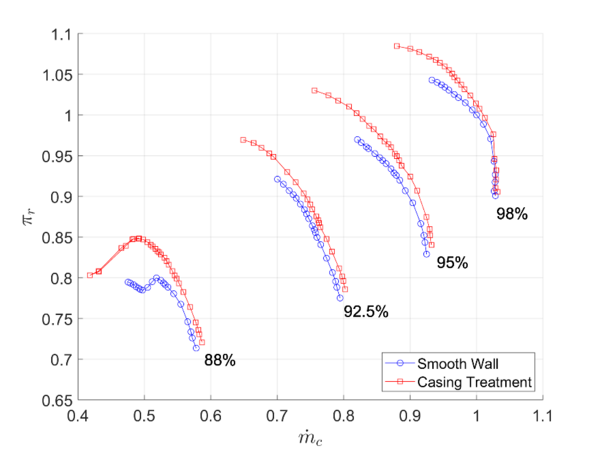
Axial compressor systems are a key component in gas-turbine engines for aviation and power generation. The ability of the compressor to increase gas pressure is limited by a phenomenon known as stall. A developing technology for mitigating stall is “Casing Treatments”. This refers to features such as slots or grooves machined into the casing around the compressor. Casing treatments are understood to reduce the likelihood of stall in a compressor but are generally associated with increased manufacturing costs and a decrease in efficiency.
An advanced casing treatment design was tested in a single stage transonic axial compressor at the Notre Dame Turbomachinery Laboratory (NDTL). Compressor performance data were acquired for both casing treatment and smooth wall configurations at four different corrected speeds. The results indicated an increase in rotor pressure ratio and stall margin at all operating conditions with the application of the casing treatment. Efficiency increases were observed with the casing treatment at design conditions and some off-design conditions. Accompanying numerical simulations from General Electric (GE) were conducted for the two case configurations. These results tested the validity of part-wheel Unsteady Reynolds-Averaged Navier-Stokes (URANS) as a tool to predict casing treatment effects on performance. The combination of experimental and numerical results allowed for a detailed investigation of relevant blade passage flow physics changes due to the casing treatment.
Additional details can be found in the forthcoming IGTI conference paper: Experimental and Computational Investigation of an Advanced Casing Treatment in a Single Stage High Speed Axial Compressor, in Turbo Expo: Power for Land, Sea, and Air, American Society of Mechanical Engineers, expected Summer 2022 (GT 2022-83459). Please send inquiries to ndturbo@nd.edu.

Figure 1: Rotor-exit total pressure ratio as a function of corrected mass flow rate; smooth wall (blue) and casing treatment (red) configurations.
By Nicholas Maher
Published by Jasmin Avila-Sacco
Originally published by at turbo.nd.edu on June 03, 2022.